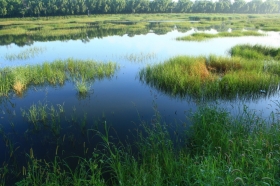 Even after 100 years have passed a restored wetland may not reach the state of its former glory. A new study in the open access journal PLoS Biology finds that restored wetlands may take centuries to recover the biodiversity and carbon sequestration of original wetlands, if they ever do. The study questions laws, such as in the U.S., which allow the destruction of an original wetland so long as a similar wetland is restored elsewhere.
Even after 100 years have passed a restored wetland may not reach the state of its former glory. A new study in the open access journal PLoS Biology finds that restored wetlands may take centuries to recover the biodiversity and carbon sequestration of original wetlands, if they ever do. The study questions laws, such as in the U.S., which allow the destruction of an original wetland so long as a similar wetland is restored elsewhere.
“Once you degrade a wetland, it doesn’t recover its normal assemblage of plants or its rich stores of organic soil carbon, which both affect natural cycles of water and nutrients, for many years,” said lead author David Moreno-Mateos, with the University of California, Berkeley, in a press release. “Even after 100 years, the restored wetland is still different from what was there before, and it may never recover.”
Looking at over 124 studies on wetland restoration covering 621 wetlands around the world (though 80 percent of them were in the U.S.), the study found that 50-100 years after restoration, wetlands still stored 23 percent less carbon and had 26 less plant species than pristine wetlands. On average restored wetlands were a quarter less productive than original wetlands. The study also found that wetlands in colder regions took longer to restore ecosystem services than those in warmer areas.
“Wetlands accumulate a lot of carbon, so when you dry up a wetland for agricultural use or to build houses, you are just pouring this carbon into the atmosphere,” says Moreno-Mateos. “If we keep degrading or destroying wetlands, for example through the use of mitigation banks, it is going to take centuries to recover the carbon we are losing.”
Source : ENN



































